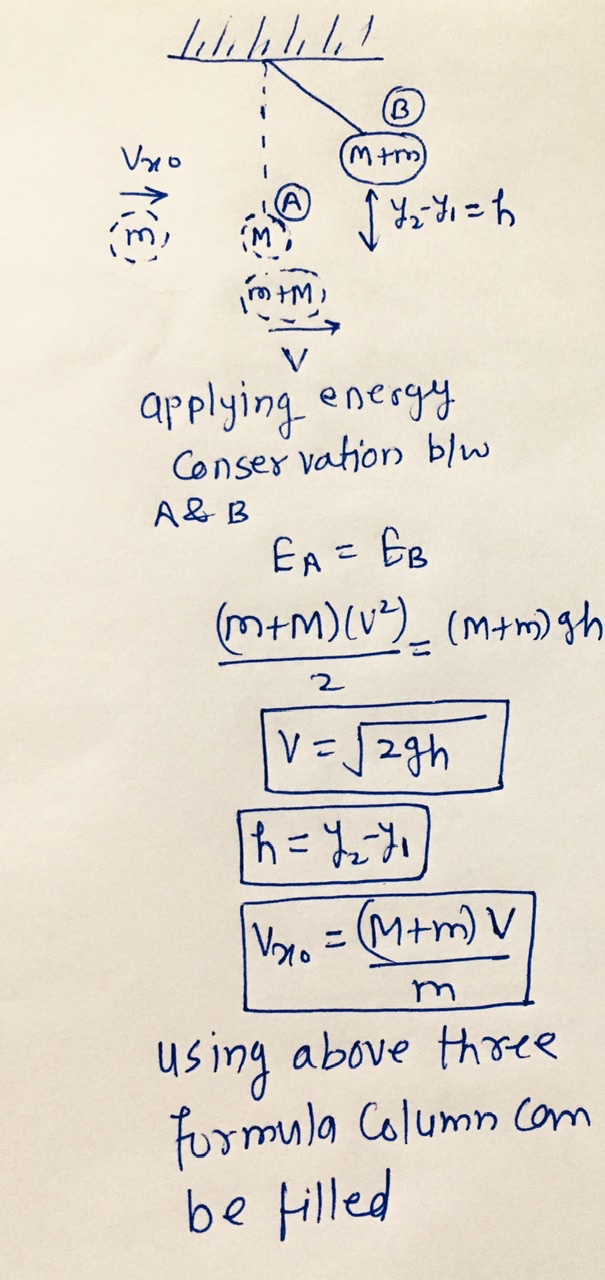College Physics
11th Edition
ISBN:9781305952300
Author:Raymond A. Serway, Chris Vuille
Publisher:Raymond A. Serway, Chris Vuille
Chapter1: Units, Trigonometry. And Vectors
Section: Chapter Questions
Problem 1CQ: Estimate the order of magnitude of the length, in meters, of each of the following; (a) a mouse, (b)...
Related questions
Question
Need help filling out this graph


Transcribed Image Text:THEORY
Ballistic Pendulum
The principle of conservation of momentum states that the total momentum of a system of particles
remains constant if there are no external forces acting on the system. Collision processes are good examples
of this concept. A collision is called elastic if kinetic energy is also conserved. An inelastic collision is one in
which some kinetic energy is lost. If the colliding particles stick together, the collision is called completely
inelastic, and the maximum possible loss of kinetic energy occurs. In this laboratory we will use a ballistic
pendulum to measure the velocity of a ball projected by a spring gun. Figure 13-1 shows a ball of mass m
moving initially in the horizontal direction with speed vro that then strikes a pendulum designed to catch
the ball. The pendulum of mass M catches the ball and swings about pivot point O to some maximum
height y2 above its original height y1. The system of ball plus pendulum rises a vertical distance of y2 – Yı as
a result of the process.
Momentum is conserved because the only forces acting on the ball and the pendulum in the direction of
motion are the forces of the collision. The two particles stick together after the collision and move with the
same velocity V. The equation for conservation of momentum is
: (т+ M)V
(Eq. 1)
MVxo =

Transcribed Image Text:LABORATORY REPORT
Data Table 1
Calculations Table 1
Trial
y2 (cm)
Y2 (m)
Y2 - Yı (m)
V (m/s)
Vxo (m/s)
1
0.145
2
0,145
0.147
4
0.143
0.143
m=0.0578kg | M= 0,200 kg | y1 =0.04 00
m/s
m
m/s
Expert Solution
Step 1

Trending now
This is a popular solution!
Step by step
Solved in 2 steps with 2 images

Knowledge Booster
Learn more about
Need a deep-dive on the concept behind this application? Look no further. Learn more about this topic, physics and related others by exploring similar questions and additional content below.Recommended textbooks for you

College Physics
Physics
ISBN:
9781305952300
Author:
Raymond A. Serway, Chris Vuille
Publisher:
Cengage Learning

University Physics (14th Edition)
Physics
ISBN:
9780133969290
Author:
Hugh D. Young, Roger A. Freedman
Publisher:
PEARSON

Introduction To Quantum Mechanics
Physics
ISBN:
9781107189638
Author:
Griffiths, David J., Schroeter, Darrell F.
Publisher:
Cambridge University Press

College Physics
Physics
ISBN:
9781305952300
Author:
Raymond A. Serway, Chris Vuille
Publisher:
Cengage Learning

University Physics (14th Edition)
Physics
ISBN:
9780133969290
Author:
Hugh D. Young, Roger A. Freedman
Publisher:
PEARSON

Introduction To Quantum Mechanics
Physics
ISBN:
9781107189638
Author:
Griffiths, David J., Schroeter, Darrell F.
Publisher:
Cambridge University Press

Physics for Scientists and Engineers
Physics
ISBN:
9781337553278
Author:
Raymond A. Serway, John W. Jewett
Publisher:
Cengage Learning

Lecture- Tutorials for Introductory Astronomy
Physics
ISBN:
9780321820464
Author:
Edward E. Prather, Tim P. Slater, Jeff P. Adams, Gina Brissenden
Publisher:
Addison-Wesley

College Physics: A Strategic Approach (4th Editio…
Physics
ISBN:
9780134609034
Author:
Randall D. Knight (Professor Emeritus), Brian Jones, Stuart Field
Publisher:
PEARSON